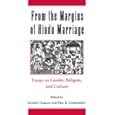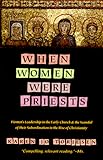Originally written in the late ’90s regarding the reading list of a truly fascinating anthropology class. The papers are extremely light — basically just some quick review and discussion questions. I include them here mostly because the books were excellent and well worth reading for thoughtful perspectives on women’s roles in a variety of religions.

From the Margins of Hindu Marriage: Essays on Gender, Religion & Culture.
edited by Lindsey Harlan and Paul B. Courtright [paper II]
For me, the most puzzling new concept in this week’s reading (the remaining chapters of this book) concerned the ubiquity and totality of marriage as the sum total and ultimate goal for women. I realize this may seem judgmental, as if I am trying to create the Other through personal distancing, but I’d like to think that is not the case. I’m trying to understand a point of view, a mind set so all encompassing that I despair sometimes of ever being able to mentally encompass it.
Consider: the chapters concern women on the margin — the “jungli rani,” the satimata*, Mira Bai, and speculations on how divorce and adultery are managed within the culture. All of these discourses reflect resistance to the classic ‘women’s roles’ in Indian society… and yet in some fashion, all of them seem unable to move beyond the role of wife as a woman’s ultimate goal.
None of the women in these readings really changes the perceptions of what a woman should be or want. The marginal woman still finds her location within the samskara (literal translation: “religious rite”) of marriage. Frequently they are the breadwinners of the family. Yet none of them have moved beyond the marriage ritual. The ability to do so, the path to take, to be more than just a married person is there in the culture before them. Why are none of these women interested in emulating men, for example, in order to gain for themselves, both as individuals and as a group, more autonomy?
I realize the society itself has many barriers to such an act of resistance. Hegemonic thought is massively difficult to counter, precisely because it is believed to be everyday ‘common sense.’ Yet surely somewhere someone has tried this path, the path of self-autonomy? Or has this already happened, and been carefully suppressed? I find this a difficult and disturbing question, and I’d love to discuss it more in class in an effort to understand why this is so.
* Literal translation: “good woman,” a woman who has immolated herself on her husband’s funeral pyre. In this case although the woman in question had attempted to become sati, she had been prevented by legal authorities. However, she was seen by the people as having succeeded in bringing the blessings of sati upon her dead husband’s spirit, and thus she also became a local saint, or person of great religious significance.
Enduring Grace: Living Portraits of Seven Women Mystics
by Carol Lee Flinders
This week’s readings covered Enduring Grace. Unfortunately (in a fashion) it was clearly and carefully written, and after reading it I was not left with any outstanding questions or puzzlement. The need to become closer to god, the need to find one’s inner voice, and the need to see god as ungendered love all make very good sense to me.
If I had to compose a question or discussion topic from this week’s reading I’d probably check to see if everyone understood that for these women, physical enclosure meant freedom.
Alternatively, if I were going to cover previous readings also, I’d probably try relating the themes covered in Enduring Grace back upon the two previous books we’d read. For example, each of the Christian mystics seemed to feel that god was approachable only when they could dedicate themselves entirely to that quest. There did not seem to be an equivalent of “doing one’s duty” as a wife and mother, as an acceptable way of becoming one with god.
It might be interesting to compare and contrast Hinduism and Christianity to review what caused this difference in attitude amongst the women we’ve read about. Hinduism, for example, allows for multiple lives and multiple efforts at increasing one’s dharma. With Christianity, however, one seems to have only one chance to make it to heaven. The impression one occasionally gets is one shouldn’t waste that one shot at eternal bliss.
Other Excellent & Recommended Books from this Course
 Fundamentalism and Gender
Fundamentalism and Gender
edited by John Stratton Hawley
 When Women Were Priests: Women’s Leadership in the Early Church and the Scandal of Their Subordination in the Rise of Christianity
When Women Were Priests: Women’s Leadership in the Early Church and the Scandal of Their Subordination in the Rise of Christianity
by Karen Jo Torjesen


